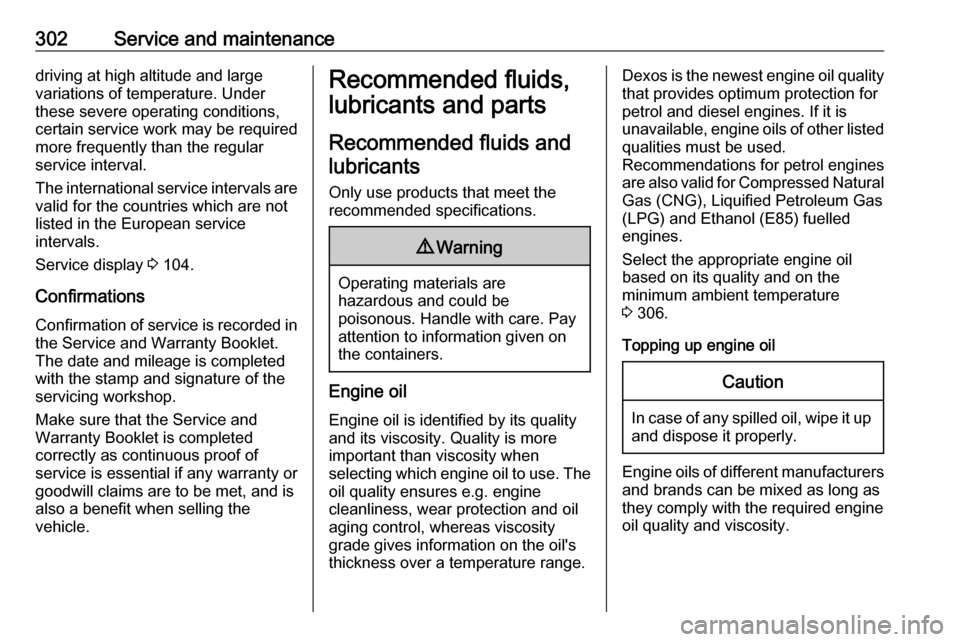engine OPEL INSIGNIA BREAK 2019 Manual user
[x] Cancel search | Manufacturer: OPEL, Model Year: 2019, Model line: INSIGNIA BREAK, Model: OPEL INSIGNIA BREAK 2019Pages: 347, PDF Size: 9.79 MB
Page 300 of 347

298Vehicle careDo not clean the engine compartmentwith a steam-jet or high-pressure jet
cleaner.
Thoroughly rinse and leather-off the
vehicle. Rinse leather frequently. Use
separate leathers for painted and
glass surfaces: remnants of wax on
the windows will impair vision.
Have the door hinges of all doors
greased by a workshop.
Do not use hard objects to remove
spots of tar. Use tar removal spray on painted surfaces.
Exterior lights
Headlight and other light covers are
made of plastic. Do not use any
abrasive or caustic agents, do not use an ice scraper, and do not clean them
dry.
Polishing and waxing
Wax the vehicle regularly (at the
latest when water no longer beads).
Otherwise, the paintwork will dry out.
Polishing is necessary only if the paint
has become dull or if solid deposits
have become attached to it.Paintwork polish with silicone forms a
protective film, making waxing
unnecessary.
Plastic body parts must not be treated with wax or polishing agents.
Windows and windscreen wiper
blades
Switch off wipers before handling in
their areas.
Use a soft lint-free cloth or chamois
leather together with window cleaner
and insect remover.
When cleaning the rear window from
inside, always wipe in parallel to the
heating element to prevent damage.
For mechanical removal of ice, use a
sharp-edged ice scraper. Press the
scraper firmly against the glass so
that no dirt can get under it and
scratch the glass.
Clean smearing wiper blades with a
soft cloth and window cleaner.
Remove dirt residues from smearing
wiper blades by using a soft cloth and window cleaner. Also make sure toremove any residues such as wax,
insect residues and similar from the
window.
Ice residues, pollution and continuous
wiping on dry windows will damage or
even destroy the wiper blades.
Sunroof Never clean with solvents or abrasive
agents, fuels, aggressive media
(e.g. paint cleaner, acetone-
containing solutions etc.), acidic or
highly alkaline media or abrasive
pads. Do not apply wax or polishing
agents to the sunroof.
Wheels and tyres
Do not use high-pressure jet
cleaners.
Clean rims with a pH-neutral wheel
cleaner.
Rims are painted and can be treated
with the same agents as the body.
Page 303 of 347

Service and maintenance301Service and
maintenanceGeneral information ...................301
Service information ..................301
Recommended fluids, lubricants and parts .................................... 302
Recommended fluids and lubricants ................................ 302General information
Service information In order to ensure economical and
safe vehicle operation and to
maintain the value of your vehicle, it
is of vital importance that all
maintenance work is carried out at the proper intervals as specified.
The detailed, up-to-date service
schedule for your vehicle is available
at the workshop.
Service display 3 104.
European service intervals Maintenance of your vehicle is
required every 30,000 km or after one year, whichever occurs first.
Additional engine oil and filter change
is indicated by the engine oil life
system, when required earlier than
maintenance.
A shorter service interval can be valid
for severe driving behaviour, e.g. for
taxis and police vehicles.
The European service intervals are
valid for the following countries:Andorra, Austria, Belgium, Bosnia-
Herzegovina, Bulgaria, Croatia,
Cyprus, Czech Republic, Denmark,
Estonia, Finland, France, Germany,
Greece, Greenland, Hungary,
Iceland, Ireland, Italy, Latvia,
Liechtenstein, Lithuania,
Luxembourg, Macedonia, Malta,
Monaco, Montenegro, Netherlands,
Norway, Poland, Portugal, Romania,
San Marino, Serbia, Slovakia,
Slovenia, Spain, Sweden,
Switzerland, United Kingdom.
Service display 3 104.
International service intervals
Maintenance of your vehicle is
required every 15,000 km or after 1 year , whichever occurs first, unless
otherwise indicated in the service
display.
Severe operating conditions exist if one or more of the following
circumstances occur frequently: Cold
starting, stop and go operation, trailer operation, mountain driving, driving
on poor and sandy road surfaces,
increased air pollution, presence of
airborne sand and high dust content,
Page 304 of 347

302Service and maintenancedriving at high altitude and large
variations of temperature. Under
these severe operating conditions,
certain service work may be required more frequently than the regular
service interval.
The international service intervals are
valid for the countries which are not
listed in the European service
intervals.
Service display 3 104.
Confirmations Confirmation of service is recorded inthe Service and Warranty Booklet.
The date and mileage is completed
with the stamp and signature of the
servicing workshop.
Make sure that the Service and
Warranty Booklet is completed
correctly as continuous proof of
service is essential if any warranty or
goodwill claims are to be met, and is
also a benefit when selling the
vehicle.Recommended fluids,
lubricants and parts
Recommended fluids and lubricants
Only use products that meet the
recommended specifications.9 Warning
Operating materials are
hazardous and could be
poisonous. Handle with care. Pay
attention to information given on
the containers.
Engine oil
Engine oil is identified by its quality
and its viscosity. Quality is more
important than viscosity when
selecting which engine oil to use. The oil quality ensures e.g. engine
cleanliness, wear protection and oil
aging control, whereas viscosity
grade gives information on the oil's
thickness over a temperature range.
Dexos is the newest engine oil quality
that provides optimum protection for
petrol and diesel engines. If it is
unavailable, engine oils of other listed qualities must be used.
Recommendations for petrol engines
are also valid for Compressed Natural
Gas (CNG), Liquified Petroleum Gas
(LPG) and Ethanol (E85) fuelled
engines.
Select the appropriate engine oil
based on its quality and on the
minimum ambient temperature
3 306.
Topping up engine oilCaution
In case of any spilled oil, wipe it up and dispose it properly.
Engine oils of different manufacturersand brands can be mixed as long as
they comply with the required engine
oil quality and viscosity.
Page 305 of 347

Service and maintenance303Use of engine oils for all petrol
engines with only ACEA quality is
prohibited, since it can cause engine
damage under certain operating
conditions.
Select the appropriate engine oil based on its quality and on the
minimum ambient temperature
3 306.
Additional engine oil additives
The use of additional engine oil
additives could cause damage and
invalidate the warranty.
Engine oil viscosity grades
The SAE viscosity grade gives
information on the thickness of the oil.
Multigrade oil is indicated by two
figures, e.g. SAE 5W-30. The first
figure, followed by a W, indicates the
low temperature viscosity and the
second figure the high temperature viscosity.
Select the appropriate viscosity grade depending on the minimum ambient
temperature 3 306.All of the recommended viscosity
grades are suitable for high ambient
temperatures.
Coolant and antifreeze
Use only organic acid type-long life
coolant (LLC) antifreeze approved for
the vehicle. Consult a workshop.
The system is factory filled with
coolant designed for excellent
corrosion protection and frost
protection down to approx. -28 °C. In
cold regions with very low
temperatures the factory filled coolant
provides frost protection down to
approx. -37 °C. This concentration
should be maintained all year round.
The use of additional coolant
additives that intend to give additional
corrosion protection or seal against
minor leaks can cause function
problems. Liability for consequences
resulting from the use of additional
coolant additives will be rejected.Washer fluid
Use only washer fluid approved for
the vehicle to prevent damage of
wiper blades, paintwork, plastic and
rubber parts. Consult a workshop.
Brake and clutch fluid Over time, brake fluid absorbs
moisture which will reduce braking
effectiveness. The brake fluid should therefore be replaced at the specified
interval.
AdBlue Only use AdBlue to reduce the
nitrogen oxides in the exhaust
emission 3 187.
Page 306 of 347

304Technical dataTechnical dataVehicle identification..................304
Vehicle Identification Number ..304
Identification plate ...................304
Engine identification ................305
Vehicle data ............................... 306
Recommended fluids and lubricants ................................ 306
Engine data ............................. 309
Performance ............................ 311
Vehicle weight ......................... 314
Vehicle dimensions .................317
Capacities ................................ 318
Tyre pressures ........................ 319
Towing hitch installation dimensions ............................. 324Vehicle identification
Vehicle IdentificationNumber
The Vehicle Identification Number is
visible through the windscreen.
The Vehicle Identification Number
may be stamped on the identification
plate and on the floor pan, under the floor covering, visible under a cover,
or in the engine compartment on the
right body panel.
Identification plate
The identification label is located on
the front left or right door frame.
Page 307 of 347

Technical data305Information on identification plate:1:manufacturer2:type approval number3:vehicle identification number4:permissible gross vehicle weightrating in kg5:permissible gross train weight in
kg6:maximum permissible front axle
load in kg7:maximum permissible rear axle
load in kg8:vehicle-specific or country-
specific data, e.g. MY = model
year
The combined total of front and rear
axle loads must not exceed the
permissible gross vehicle weight. For
example, if the front axle is bearing its
maximum permissible load, the rear
axle can only bear a load that is equal
to the gross vehicle weight minus the front axle load.
The technical data is determined in
accordance with European
Community standards. We reserve
the right to make modifications.
Specifications in the vehicle
documents always have priority over those given in this manual.
Engine identification The technical data tables use the
engine identifier code. The engine
data table additionally shows the
engineering code. Engine data
3 309.
To identify the respective engine,
refer to the EEC Certificate of
Conformity provided with your vehicle
or other national registration
documents.
The Certificate of Conformity shows the engine identifier code, other
national publications may show the
engineering code. Check piston
displacement and engine power to
identify the respective engine.
Page 308 of 347

306Technical dataVehicle dataRecommended fluids and lubricantsEuropean service schedule Required engine oil qualityAll countries with European service interval 3 301Engine oil qualityPetrol engines
(including CNG, LPG, E85)Diesel enginesdexos1 Gen2✔–dexos2–✔
Diesel engines only: In case dexos quality is unavailable, you may use max. one litre engine oil quality ACEA C3 once
between each oil change.
Engine oil viscosity grades
All countries with European service interval 3 301Ambient temperaturePetrol and diesel enginesdown to -25 °CSAE 0W-20 or SAE 0W-30 or SAE 0W-40SAE 5W-30 or SAE 5W-40below -25 °CSAE 0W-20 orSAE 0W-30 or SAE 0W-40
Page 309 of 347

Technical data307International service scheduleRequired engine oil qualityAll countries with international service interval 3 301Engine oil qualityPetrol engines
(including CNG, LPG, E85)Diesel enginesdexos1 Gen2✔–dexos2–✔
In case dexos quality is unavailable you may use the oil qualities listed below:
All countries with international service interval 3 301Engine oil qualityPetrol engines
(including CNG, LPG, E85)Diesel enginesACEA A3/B4–✔ACEA C3–✔
Engine oil viscosity grades
All countries with international service interval 3 301Ambient temperaturePetrol and diesel enginesdown to -25 °CSAE 0W-20 orSAE 0W-30 or SAE 0W-40SAE 5W-30 or SAE 5W-40
Page 311 of 347
![OPEL INSIGNIA BREAK 2019 Manual user Technical data309Engine dataEngine identifier codeB15XHLB15XHTD16SHTSales designation1.5T1.5T1.6TEngineering codeB15XHTB15XHTD16SHTPiston displacement [cm3
]149014901598Engine power [kW]103121147at rp OPEL INSIGNIA BREAK 2019 Manual user Technical data309Engine dataEngine identifier codeB15XHLB15XHTD16SHTSales designation1.5T1.5T1.6TEngineering codeB15XHTB15XHTD16SHTPiston displacement [cm3
]149014901598Engine power [kW]103121147at rp](/img/37/18870/w960_18870-310.png)
Technical data309Engine dataEngine identifier codeB15XHLB15XHTD16SHTSales designation1.5T1.5T1.6TEngineering codeB15XHTB15XHTD16SHTPiston displacement [cm3
]149014901598Engine power [kW]103121147at rpm560056005500Torque [Nm]250250280at rpm2000-41002000-45001650-4500Fuel typePetrolPetrolPetrolOctane rating RON 2)recommended959595possible989898possible919191Additional fuel type–––2)
A country-specific label at the fuel filler flap can supersede the engine-specific requirement.
Page 312 of 347
![OPEL INSIGNIA BREAK 2019 Manual user 310Technical dataEngine identifier codeD16DTID16DTHD20DTHD20DTRSales designation1.61.62.02.0Engineering codeD16DTID16DTHD20DTHD20DTRPiston displacement [cm3
]1598159819561956Engine power [kW]811001251 OPEL INSIGNIA BREAK 2019 Manual user 310Technical dataEngine identifier codeD16DTID16DTHD20DTHD20DTRSales designation1.61.62.02.0Engineering codeD16DTID16DTHD20DTHD20DTRPiston displacement [cm3
]1598159819561956Engine power [kW]811001251](/img/37/18870/w960_18870-311.png)
310Technical dataEngine identifier codeD16DTID16DTHD20DTHD20DTRSales designation1.61.62.02.0Engineering codeD16DTID16DTHD20DTHD20DTRPiston displacement [cm3
]1598159819561956Engine power [kW]81100125154at rpm35003500-400037504000Torque [Nm]300320400480at rpm1750-20002000-22501750-25001500Fuel typeDieselDieselDieselDiesel